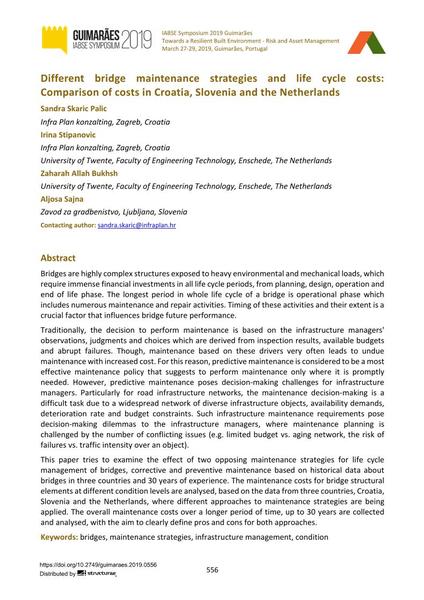Different bridge maintenance strategies and life cycle costs: Comparison of costs in Croatia, Slovenia and the Netherlands

|
|
|||||||||||
Bibliografische Angaben
| Autor(en): |
Sandra Skaric Palic
(Infra Plan konzalting, Zagreb, Croatia)
Irina Stipanovič (Infra Plan konzalting, Zagreb, Croatia; University of Twente, Faculty of Engineering Technology, Enschede, The Netherlands) Zaharah Allah Bukhsh (University of Twente, Faculty of Engineering Technology, Enschede, The Netherlands) Aljoša Šajna (Zavod za gradbenistvo, Ljubljana, Slovenia) |
||||
|---|---|---|---|---|---|
| Medium: | Tagungsbeitrag | ||||
| Sprache(n): | Englisch | ||||
| Tagung: | IABSE Symposium: Towards a Resilient Built Environment Risk and Asset Management, Guimarães, Portugal, 27-29 March 2019 | ||||
| Veröffentlicht in: | IABSE Symposium Guimarães 2019 | ||||
|
|||||
| Seite(n): | 556-562 | ||||
| Anzahl der Seiten (im PDF): | 7 | ||||
| DOI: | 10.2749/guimaraes.2019.0556 | ||||
| Abstrakt: |
Bridges are highly complex structures exposed to heavy environmental and mechanical loads, which require immense financial investments in all life cycle periods, from planning, design, operation and end of life phase. The longest period in whole life cycle of a bridge is operational phase which includes numerous maintenance and repair activities. Timing of these activities and their extent is a crucial factor that influences bridge future performance. Traditionally, the decision to perform maintenance is based on the infrastructure managers' observations, judgments and choices which are derived from inspection results, available budgets and abrupt failures. Though, maintenance based on these drivers very often leads to undue maintenance with increased cost. For this reason, predictive maintenance is considered to be a most effective maintenance policy that suggests to perform maintenance only where it is promptly needed. However, predictive maintenance poses decision-making challenges for infrastructure managers. Particularly for road infrastructure networks, the maintenance decision-making is a difficult task due to a widespread network of diverse infrastructure objects, availability demands, deterioration rate and budget constraints. Such infrastructure maintenance requirements pose decision-making dilemmas to the infrastructure managers, where maintenance planning is challenged by the number of conflicting issues (e.g. limited budget vs. aging network, the risk of failures vs. traffic intensity over an object). This paper tries to examine the effect of two opposing maintenance strategies for life cycle management of bridges, corrective and preventive maintenance based on historical data about bridges in three countries and 30 years of experience. The maintenance costs for bridge structural elements at different condition levels are analysed, based on the data from three countries, Croatia, Slovenia and the Netherlands, where different approaches to maintenance strategies are being applied. The overall maintenance costs over a longer period of time, up to 30 years are collected and analysed, with the aim to clearly define pros and cons for both approaches. |
||||
| Stichwörter: |
Brücken
|
||||
